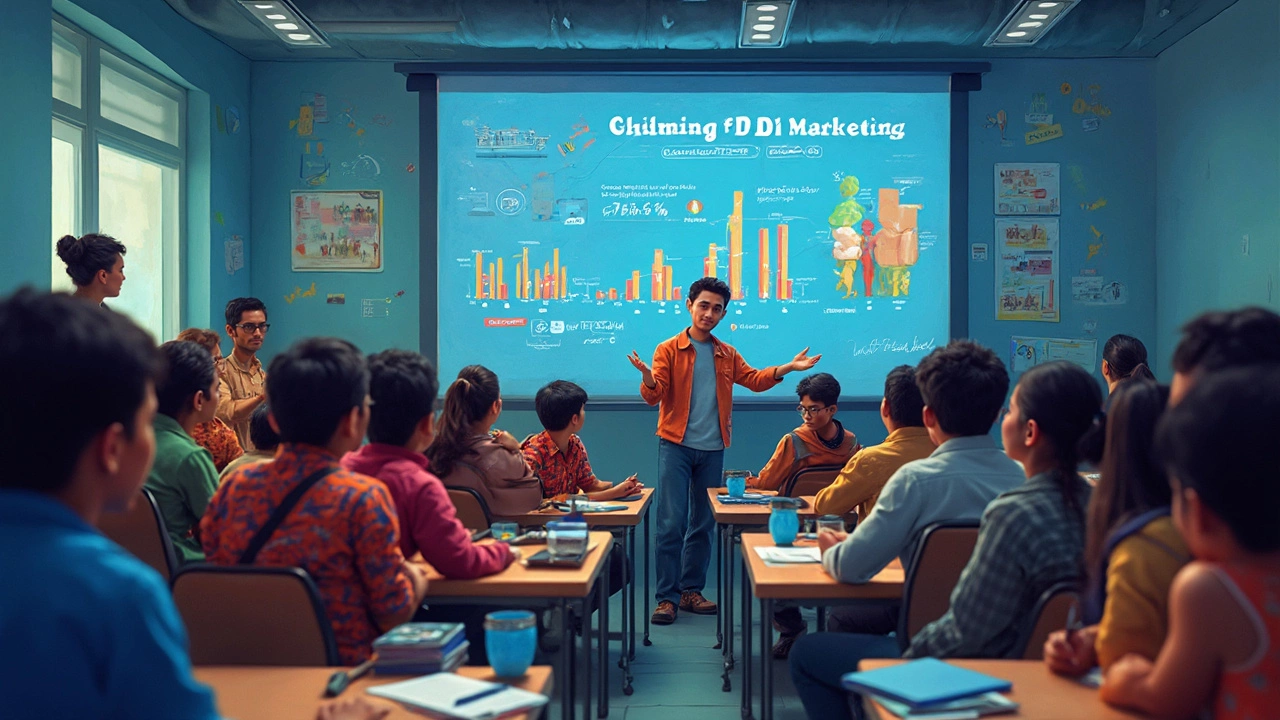Ever feel like everyone's doing digital marketing but nobody's sure if it really pays off anymore? The truth is, the game keeps changing. Once, just running Facebook ads felt like magic. Fast forward to 2025—half the tactics that worked last year feel ancient already.
Here’s the deal: brands are still sinking billions into digital campaigns. The reason? People’s eyes are glued to their screens more than ever, especially after 2024’s wave of new social platforms and AI tools. Tried running Google ads lately? Costs have jumped, but a killer strategy can still deliver, especially with smart automations and good content.
If you’re thinking about learning digital marketing or maybe boosting your skills, stick around. I’ll cut through the fluff—no buzzwords, just what’s actually getting clicks and sales right now. And if you want to stay competitive, it’s not about learning every trick, but knowing what really matters today.
- What’s Changed in Digital Marketing?
- Where’s the Real Money Going?
- What Skills Actually Matter Now?
- Is a Digital Marketing Course Still Relevant?
- Tips to Get the Most Out of Digital Marketing
What’s Changed in Digital Marketing?
It’s wild how different digital marketing looks compared to just a couple of years ago. For starters, privacy rules stepped up—thanks to laws like Europe’s GDPR and India’s Digital Personal Data Protection Act. Third-party cookies? Pretty much dead. Marketers can’t just follow people around the internet like they used to, so now brands have to get smart with first-party data (the info you collect directly from your own website or app).
Short video is basically running the show. TikTok kicked it off, but now YouTube Shorts, Instagram Reels, and even LinkedIn joined the club. Static ads and long-winded blog posts aren’t cutting it alone. If you can’t snag attention in five seconds, you’re out.
AI changed the game big time. It’s not just writing basic ad copy. Marketers are using AI for everything—creating images for ads, optimizing headlines, even handling support chats. But those who rely completely on AI? Their stuff feels generic fast. It’s all about mixing tech with real human ideas.
Also, search isn’t just Google anymore. Gen Z is searching for stuff directly in social media apps like Instagram or TikTok way more than before. If your business isn’t popping up there, you’re basically invisible to a huge chunk of buyers.
One last thing: trust is down. After waves of fake news and weird ads, people trust influencers more than traditional ads. But even influencers have to show proof and real results now—just saying “This product is awesome” isn’t enough.
Where’s the Real Money Going?
Let’s talk about where companies are actually dropping their cash. It’s not the random banner ads or email blasts from 2015. These days, budgets are shifting fast toward data-driven campaigns and influencer deals. Most businesses are funneling more money into platforms that give them solid data on what’s working—think YouTube, Instagram, and search ads with real demographics you can track.
If you check the latest stats, spending on short-form video ads nearly doubled in the last two years. TikTok and Instagram Reels are eating up a huge share of budgets. It’s simple: bite-sized videos convert. A recent industry survey showed that 61% of marketers got the best ROI from short videos, with brands like Nike and Zomato seeing double-digit jumps in engagement.
But there’s more. Influencer marketing isn’t just for big-name celebrities anymore. Nano-influencers—people with 1,000 to 10,000 followers—are crushing it because they’re real and affordable. Brands pay less per post, but the trust factor with their audiences is through the roof. According to a 2025 report from HubSpot, every $1 spent on influencer marketing generates $5.12 on average in sales—a stat most traditional ads can’t touch.
Here’s a quick breakdown where ad cash is flowing right now:
- Short-form video ads (TikTok, Instagram Reels, YouTube Shorts)
- Influencer and nano-influencer collaborations
- Search ads with real data targeting (Google, Bing)
- Content marketing—think blogs, guides, product demos
- Interactive ads and AI-powered chatbots
If you want numbers, see what’s happening in the digital marketing world in 2025:
| Channel | Growth (2024-2025) | Average ROI |
|---|---|---|
| Short Video Ads | +78% | 22:1 |
| Influencer Marketing | +52% | 5.1:1 |
| Search Ads | +24% | 6:1 |
| Email Marketing | +15% | 4:1 |
| Display/Banner Ads | -10% | 1.2:1 |
If you’re thinking about starting a campaign or picking a spot to invest your digital energy, follow the money. That’s where results—and jobs—are headed. Focusing on digital marketing courses that teach video content, influencer outreach, and data-driven campaigns is way smarter than sticking to just old-school strategies.

What Skills Actually Matter Now?
The digital marketing world in 2025 is flooded with tools, courses, and promises. But what actually helps you land clients or a good job? Spoiler: knowing how to run a random ad is not enough anymore. Hiring managers are after folks who understand the basics but can also adapt fast as algorithms and trends change.
First, let’s talk data. Companies want marketers who can read analytics like a story, not just toss around big numbers. Google Analytics 4 is the industry standard, but many also use platforms like HubSpot and Adobe Analytics. Understanding what’s actually working—or flopping—makes you way more valuable than someone chasing likes.
Next, think content. Sure, anybody can post memes or quotes, but brands pay for people who create stuff that grabs attention and drives action. Short-form video is king right now, mainly on platforms like TikTok, Instagram Reels, and YouTube Shorts. According to a 2025 Statista report, 84% of marketers say video brings the best return on investment. That’s hard to ignore.
SEO isn’t dead—it’s just got way tougher. Google’s AI-based ranking system means you need to make content that’s actually useful, answers real questions, and keeps people engaged. Keyword stuffing got left behind in 2022. Focus on understanding what your audience is searching for and align your content smartly—being the best with digital marketing means cutting through the noise like this.
Let’s not forget marketing automation. Platforms like Mailchimp, HubSpot, and ActiveCampaign save hours every week. Having skills in setting up smart automations and knowing when not to overdo it (nobody wants ten emails a day) is a big win for any team.
Here’s a snapshot comparing must-have skills and if they’re still worth investing time in:
| Skill | Still in Demand (2025)? | Where to Focus |
|---|---|---|
| SEO | Yes | Human-focused, helpful content |
| Data Analytics | Huge | GA4, Insightful reporting |
| Video Content Creation | Absolutely | Short-form, social-first |
| PPC Ad Management | Yes (but expensive) | Smart targeting, budget control |
| Automation | Yes | Email flows, workflow setup |
| Copywriting | Always | Clear, action-driving messages |
Want a real pro tip? Get comfy with AI tools but don’t rely on them to do all the thinking. The folks who use AI to speed up tasks—like brainstorming headlines or editing quick videos—but still bring new ideas, are the ones getting hired and promoted.
Is a Digital Marketing Course Still Relevant?
If you’re on the fence about signing up for a digital marketing course, you’re not alone. Honestly, the biggest change today isn’t whether digital marketing is relevant—it’s how fast you need to keep up. Companies need people who get new trends, new tools, and know what actually works, not just what worked last year. So, are courses actually worth it in 2025? Let’s break it down.
First, entry-level jobs in digital marketing are still popping up everywhere. Recruiters want people who know analytics, can handle content, and get how algorithms tick. According to LinkedIn’s 2025 jobs report, digital marketing is in the top 10 skills companies want—no surprise when 68% of brands say their biggest challenge is finding skilled staff.
| Year | Global Digital Ad Spend (USD) | Unfilled Digital Marketing Roles (%) |
|---|---|---|
| 2022 | $522B | 13% |
| 2024 | $666B | 16% |
| 2025 | $710B (est.) | 15% (est.) |
Now, not all courses are created equal. There’s a ton of fluff out there. Skip anything that promises you’ll "get rich quick" or only teaches how to run Facebook ads. Instead, good courses give you up-to-date real cases, practice with real data, and help you build a portfolio—stuff that employers can actually see.
Look for these essential skills in a digital marketing course:
- Hands-on work with tools like Google Analytics, Meta Ads, and SEO platforms
- Learning how to make short-form videos (hello, TikTok & Reels)
- Basic automation with AI—everyone wants this right now
- How to read and act on campaign numbers (not just reports, but real action steps)
- Building and testing email campaigns—yep, email is back in fashion
So, if you want a job in marketing or you’re running your own business, a good digital marketing course really does make a difference today. It’s not just about collecting certificates—it’s the hands-on, practical skills that employers (and potential clients) actually care about.

Tips to Get the Most Out of Digital Marketing
If you want results, you can’t just throw money at ads and hope for the best. Here’s what actually works if you want your digital marketing to pull its weight in 2025.
- Digital marketing is more about data than ever. Track everything. Use Google Analytics 4 (GA4), not the old version. GA4 gives you better info on what users do on your site, even across devices. If you aren’t paying attention to the data, you’re basically flying blind.
- Video is king—not just short clips for TikTok, but explainers, reviews, and behind-the-scenes content. YouTube’s algorithm now boosts videos over 60 seconds that keep viewers engaged, so don’t shy away from longer formats.
- Email isn’t dead. According to a 2024 HubSpot report, email marketing still gets an average ROI of $36 for every $1 spent. But generic blasts don’t cut it—use personalization and segmentation. Address people by name, send them stuff they actually care about.
- Don’t try to win everywhere. Test a few platforms—maybe Instagram and LinkedIn if you’re B2B, or TikTok and Facebook for B2C. Focus on where your real audience hangs out. Look at your analytics to see which platforms actually drive sales, not just likes.
- AI tools like ChatGPT or Jasper can save you hours on content ideas and writing first drafts. But tweak everything before you publish so it matches your brand’s voice and feels real, not robotic.
- Never set-and-forget your ads. Click costs go up fast. Run smaller tests with A/B splits, find what works, then double down. Facebook’s Advantage+ Shopping campaigns, for example, use a ton of automation but really need human tweaks to hit top performance.
If you’re learning or improving your digital skills, try practical stuff—not just fancy theories. Run a real campaign, measure results, and tweak as you go. The people who get ahead aren’t the ones who know every buzzword, but the ones who keep testing, tracking, and fixing what isn’t working.



